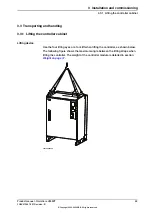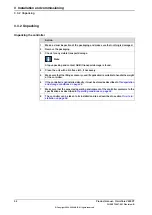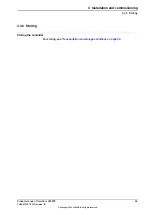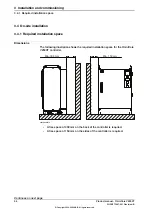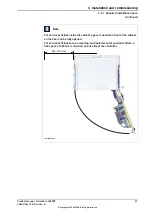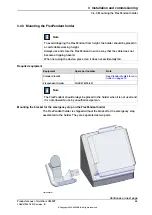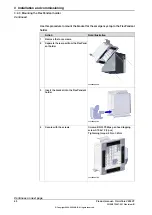
3.5.2 Connecting cables to the controller
General
A good and proper electrical installation of the robot system is necessary to ensure
the best performance and prolong the lifetime of the whole robot system.
This section includes important information on how to connect cables and signals
to the controller.
Signal classes
Different rules apply to the different classes when selecting and laying cables.
Signals from different classes must not be mixed.
Description
Signal class
Supplies external motors and brakes.
Power signals
Applies to the cables associated with the power inputs and outputs
of variable speed drives. Cables carrying strongly interfering signals
such as motor cables, DC-link load sharing, unsuppressed inductive
loads, DC motors, welding equipment, etc.
Class 4 (noisy)
Digital operating and data signals (digital I/O, protective stop, etc.).
Control signals
Applies to cables carrying slightly interfering signals: AC power
supply (<1 kV), DC power (24 V), power to equipment with RFI/EMI
filters, control circuits with resistive or suppressed inductive loads
(such as contactors and solenoids), direct-on-line induction motors,
etc.
Class 3 (slightly
noisy)
Analog measurement and control signals (resolver and analog I/O).
Measurement signals
This class covers ordinary analogue signals such as analogue sig-
nals (4-20 mA, 0-10V, or signals below 1 MHz), low-speed digital
signals (RS232, RS485), digital (on/off) signals, limit switches, en-
coders, etc.
Class 2 (slightly sens-
itive)
Gateway (fieldbus) connection, computer link.
Data communication
signals
Applies to cables carrying very sensitive signals. Signals with a full-
scale range less than 1 V or 1 mA, and/or a source impedance >1
kOhm, and/or a signal frequency >1 Mhz. For example high-speed
digital communication (Ethernet), thermocouples, thermistors, strain
gauges and flowmeters.
Class 1 (sensitive)
Selecting cables
All cables laid in the control cabinet must be capable of withstanding 70°C. In
addition, the following rules apply to the cables of certain signal classes:
Cable type
Signal class
Shielded cable with an area of at least 0.75 mm² or AWG 18.
Power signals
Shielded cable.
Control signals
Shielded cable with twisted pair conductors.
Measurement signals
Shielded cable with twisted pair conductors. A specific cable
should be used for field bus connections and Ethernet, according
to the standard specification of the respective bus.
Data communication
signals
Continues on next page
Product manual - OmniCore V250XT
67
3HAC073447-001 Revision: B
© Copyright 2020-2022 ABB. All rights reserved.
3 Installation and commissioning
3.5.2 Connecting cables to the controller
Summary of Contents for OmniCore V250XT
Page 1: ...ROBOTICS Product manual OmniCore V250XT ...
Page 34: ...This page is intentionally left blank ...
Page 50: ...This page is intentionally left blank ...
Page 174: ...This page is intentionally left blank ...
Page 410: ...This page is intentionally left blank ...
Page 418: ...This page is intentionally left blank ...
Page 454: ......
Page 455: ......

